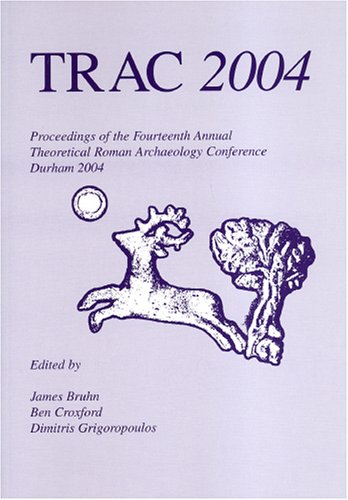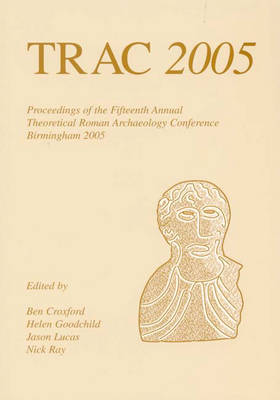TRAC
3 total works
The fourteenth Theoretical Roman Archaeology Conference was held at the University of Durham Department of Archaeology, March 2004. The papers present and discuss information drawn from as wide a range of geographical regions of the Roman Empire as the scope of theoretical and methodological approaches applied. An equally wide selection of subject matter is illustrated, including the ancient economy, historiography and modern perceptions of the Roman world, production, supply and consumption of material culture, social identities and the experience of social space and the landscape.
Contents: Preface; The economy of Roman Britain: Representation and historiography (Kevin Greene) ; Reconstructing syntheses in Romano-British cremation (Jake Weekes) ; Metalworking and Late Roman power: A Study of towns in Later Roman Britain (Adam Rogers) ; Not at random: Evidence for a regionalized coin supply? (Fleur Kemmers) ; Regional identities and the social use of ceramics (Martin Pitts) ; Social and economic aspects of glass recycling (Daniel Keller) ; Interaction and exchange in food production in the Nijmegen frontier area during the Early Roman period (Annemiek Robeerst) ; Brickworks and ladders: Explaining intra-regional diversity of late prehistoric and Roman landscapes in the territory of the Parisi (Mick A Atha) ; Beyond the temple: Blurring the boundaries of 'sacred space' (Eleanor Ghey) ; The cupae of Iberia in their monumental contexts: A study of the relationship between social status and commemoration with barrel-shaped and semi-cylindrical tombstones (Charlotte Tupman) ; The quick and the dead in the extra-urban landscape: The Roman cemetery at Ostia/ Portus as a lived environment (E J Graham) ; Houses, GIS and the micro-topology of Pompeian domestic space (Michael A Anderson) ; Unifying aspects of Roman fortresses (Mark Driessen) .
Contents: Preface; The economy of Roman Britain: Representation and historiography (Kevin Greene) ; Reconstructing syntheses in Romano-British cremation (Jake Weekes) ; Metalworking and Late Roman power: A Study of towns in Later Roman Britain (Adam Rogers) ; Not at random: Evidence for a regionalized coin supply? (Fleur Kemmers) ; Regional identities and the social use of ceramics (Martin Pitts) ; Social and economic aspects of glass recycling (Daniel Keller) ; Interaction and exchange in food production in the Nijmegen frontier area during the Early Roman period (Annemiek Robeerst) ; Brickworks and ladders: Explaining intra-regional diversity of late prehistoric and Roman landscapes in the territory of the Parisi (Mick A Atha) ; Beyond the temple: Blurring the boundaries of 'sacred space' (Eleanor Ghey) ; The cupae of Iberia in their monumental contexts: A study of the relationship between social status and commemoration with barrel-shaped and semi-cylindrical tombstones (Charlotte Tupman) ; The quick and the dead in the extra-urban landscape: The Roman cemetery at Ostia/ Portus as a lived environment (E J Graham) ; Houses, GIS and the micro-topology of Pompeian domestic space (Michael A Anderson) ; Unifying aspects of Roman fortresses (Mark Driessen) .
TRAC 2005 was held at the Institute of Archaeology and Antiquity, University of Birmingham, under the auspices of The Roman Society. Of the twenty-three papers delivered here, this volume presents eight, plus three special contributions. These three papers were commissioned to mark the fifteenth year of TRAC with the intention that they should take stock of TRAC to date and look to where it may go in the future. A very clear message is conveyed: that TRAC must continue to evolve and that a continued existence in its current form, though possible, will ultimately fail to realise further success. In seeking to engage with new ideas and theories, the endeavour symbolised by the first conference, to bring theory from the margins of Roman archaeology, continues today.
TRAC 2001
by Martin Carruthers, C Van Driel-Murray, Andrew Gardner, and Jason Lucas
Published 1 December 2002
A selection of eleven papers from the eleventh annual Theoretical Roman Archaeology Conference; these papers are representative of the broad range of Roman archaeology today, and share a commitment to a theoretically informed approach to the subject.


